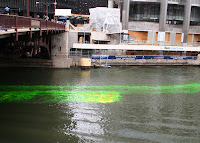
It all started with Grant, but the trip that put the “Dead Presidents” quest firmly in my mind as something doable was my trip to Springfield, IL in 2004. The saga of Lincoln’s body after his death and the size and scale of his monument got me to thinking about the other presidents and whether or not they had anything to compare with Grant or Lincoln.
After
Abraham Lincoln’s death in 1865 (he was shot on April 14th and declared dead on the 15th) Lincoln had several funerals and traveled many miles before ending up in Springfield. The first funeral service was in Washington on April 19th in the
White House The funeral procession, including Lincoln’s
catafalque, then proceeded up
Pennsylvania Avenue to the Capitol building where another service was held, and he lay in state for two days and was viewed by thousands.
On the 21st his remains and those of his son Willie who had died in 1862 were loaded on a special funeral train that first traveled to Harrisburg, PA, then Philadelphia, where he again lay in state in Independence Hall. On the 24th the train arrived in New York City and again the casket was put on view in the City Hall. The next day there was a funeral parade up Broadway witnessed by “nearly a million” people after which his casket was again loaded on the train to continue to Springfield.

After two weeks and a circuitous journey where Lincoln lay in state for public viewing and had funeral services at least three more times in Cleveland and
Columbus, Ohio and
Chicago he arrived in Springfield on May 3. He again lay in state in the capitol for a night, and after the funeral the next day his body was placed in a receiving vault at Oak Ridge Cemetery (picture left), the site Mrs. Lincoln had requested for burial. In December, his remains were removed to a temporary vault not far from the proposed memorial site. In 1871, or 3 years after laborers had begun constructing the tomb, the body of Lincoln and those of the three youngest of his sons (Edward, William and Thomas “Tad” – eldest son Robert is buried in Arlington Cemetery) were placed in crypts in the unfinished structure.
In 1874, upon completion of the memorial, Lincoln's remains were interred in a marble sarcophagus in the center of a chamber known as the "catacombs," or burial room. In 1876, however, after two Chicago criminals failed in an attempt to steal Lincoln's body and hold it for ransom, the National Lincoln Monument Association hid it in another part of the memorial. When Mrs. Lincoln died in 1882, her remains were placed with those of Lincoln, but in 1887 both bodies were reburied in a brick vault beneath the floor of the burial room.
By 1895, the year the State acquired the memorial, it had fallen into disrepair. During a rebuilding and restoration program in 1899-1901, all five caskets were moved to a nearby subterranean vault. In the latter year, State officials returned them to the burial room and placed that of Lincoln in the sarcophagus it had occupied in 1874-76. Within a few months, however, at the request of Robert Todd Lincoln, the President's only surviving son, the body was moved to its final resting place, a cement vault 10 feet below the surface of the burial room. (From the National Park Service)
After spending some time in Chicago my trip to Springfield was an eye opener: “down state” Illinois is as far from Chicago as imaginable. The town isn’t terribly large although it is the capital of the state, and its primary industry (other than the farming going on all around it) seems to be Abraham Lincoln. There is the newly expanded and reopened
Lincoln Library and Museum and the National Historic
site with the only house he ever owned, and where he lived before he went to Washington as president (his birthplace, by the way is a National Historic site in
Kentucky - that site seems like an interesting place to visit, apparently the “original cabin” is encased in a marble “Memorial Building”).
I now know why “down staters” hate Chicago so much: the city seems to be as unrelated to the rest of the state as Austin does to Texas.






